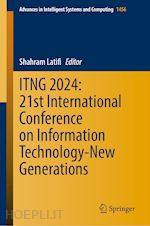
Questo prodotto usufruisce delle SPEDIZIONI GRATIS
selezionando l'opzione Corriere Veloce in fase di ordine.
Pagabile anche con Carta della cultura giovani e del merito, 18App Bonus Cultura e Carta del Docente
This volume represents the 21st International Conference on Information Technology - New Generations (ITNG), 2024. ITNG is an annual event focusing on state of the art technologies pertaining to digital information and communications. The applications of advanced information technology to such domains as astronomy, biology, education, geosciences, security, and health care are the among topics of relevance to ITNG. Visionary ideas, theoretical and experimental results, as well as prototypes, designs, and tools that help the information readily flow to the user are of special interest. Machine Learning, Robotics, High Performance Computing, and Innovative Methods of Computing are examples of related topics. The conference features keynote speakers, a best student award, poster award, service award, a technical open panel, and workshops/exhibits from industry, government and academia. This publication is unique as it captures modern trends in IT with a balance of theoretical and experimental work. Most other work focus either on theoretical or experimental, but not both. Accordingly, we do not know of any competitive literature.
Shahram Latifi, an IEEE Fellow (2002), received the Master of Science and the PhD degrees both in Electrical and Computer Engineering from Louisiana State University, Baton Rouge, in 1986 and 1989, respectively. He is currently a Professor of Electrical Engineering at the University of Nevada, Las Vegas. Dr. Latifi is the co-director of the Center for Information Technology and Algorithms (CITA) at UNLV. He has designed and taught undergraduate and graduate courses in the broad spectrum of Computer Science and Engineering in the past four decades. He has given keynotes and seminars on machine learning/AI and IT-related topics all over the world. He has authored over 250 technical articles in the areas of networking, cybersecurity, image processing, biosurveillance, biometrics, document analysis, fault tolerant computing, parallel processing, and data compression. His research has been funded by NSF, NASA, DOE, DoD, Boeing, Lockheed and Cray Inc. Dr. Latifi was an Associate Editor of the IEEE Transactions on Computers (1999-2006), an IEEE Distinguished Speaker (1997-2000), and Co-founder and General Chair of the IEEE Int'l Conf. on Information Technology (2004-2015). Dr. Latifi is the recipient of several research awards, the most recent being the Barrick Distinguished Research Award (2021). Dr. Latifi was recognized to be among the top 2% researchers around the world in December 2020, according to Stanford top 2% list (publication data in Scopus, Mendeley). He is a Registered Professional Engineer in the State of Nevada.











Il sito utilizza cookie ed altri strumenti di tracciamento che raccolgono informazioni dal dispositivo dell’utente. Oltre ai cookie tecnici ed analitici aggregati, strettamente necessari per il funzionamento di questo sito web, previo consenso dell’utente possono essere installati cookie di profilazione e marketing e cookie dei social media. Cliccando su “Accetto tutti i cookie” saranno attivate tutte le categorie di cookie. Per accettare solo deterninate categorie di cookie, cliccare invece su “Impostazioni cookie”. Chiudendo il banner o continuando a navigare saranno installati solo cookie tecnici. Per maggiori dettagli, consultare la Cookie Policy.